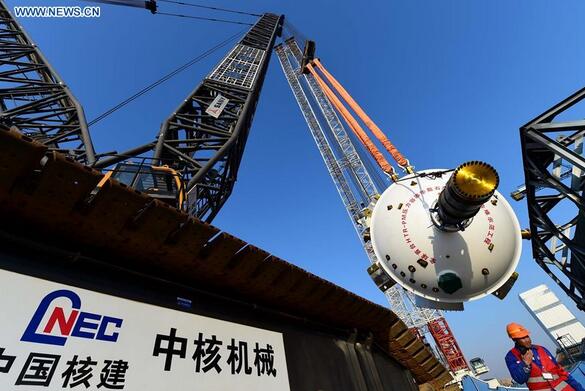China likely to build inland nuclear plants by 2020
china.org.cn / chinagate.cn by Zhang Lulu, February 15, 2017 Adjust font size:
 |
|
The pressure vessel of a high-temperature gas-cooled reactor (HTGR) is installed at the Huaneng Shidao Bay nuclear power plant, east China's Shandong Province, March 20, 2016. [Photo/Xinhua] |
China has selected sites to build inland nuclear power plants, and construction will likely begin in the next four years, according to an energy official.
Preliminary work has already begun at sites, including the Taohuajiang nuclear power plant in Hunan Province, the Xianning plant in Hubei Province and the Pengze plant in Jiangxi Province, said Wang Yiren, vice director of the State Administration of Science, Technology and Industry for National Defense, and vice-chairman of the China Atomic Energy Authority. He revealed this in an interview with China National Radio that was published on Monday.
"Construction of inland nuclear power stations will begin during the 13th Five Year Plan period (2016-2020) if things go well," the official said.
Currently a total of 35 nuclear power units are in operation and 21 units are under construction in China's coastal area, with no plants in the inland area. The country halted all nuclear plant construction projects after Japan's Fukushima nuclear disaster in 2011, but resumed the construction of plants in its coastal areas in 2012. The three power plants in question are often seen as the barometer of the country's inland nuclear policy, as they had the approval of the National Development and Reform Commission as early as 2008 but had to be called off following the Fukushima accident.
Wang cited China's inland area's increasing energy need following rapid economic development in recent years as the need for nuclear plants. He said such plants are necessary also because nuclear energy has less environmental impact than coal-fired plants. China is faced with severe air pollution and has pledged to cut its carbon dioxide emissions per unit of GDP by 18 percent by 2020.
Responding to safety concerns of inland plants, Wang asserted that China's nuclear plants use the most advanced "third generation" technology, which is very safe. "Should any nuclear accident occurs, it would be contained within the plant and the reactor." He continued by saying there are more than 400 nuclear plants in the world, most of which are in inland areas that are not prone to tsunamis or typhoons. It is safe to build inland nuclear power stations, the official stressed.
Some of China's landlocked provinces have been calling for the resumption of construction of nuclear power stations. Hunan Province, for instance, has submitted proposals to the country's annual legislative meeting in the past four years, asking to begin nuclear construction within the province.
Earlier reports said central China's Henan Province will build four nuclear plants by 2020, which raised much concern in early February. But officials and experts in the province later refuted the reports, saying the plants are not included in the country's nuclear plant plan.
According to the 13th Five-Year Plan for the energy sector, China's operational nuclear power capacity will almost double to 58 million kilowatts by 2020, and 30 million kilowatts of capacity will be under construction by then.